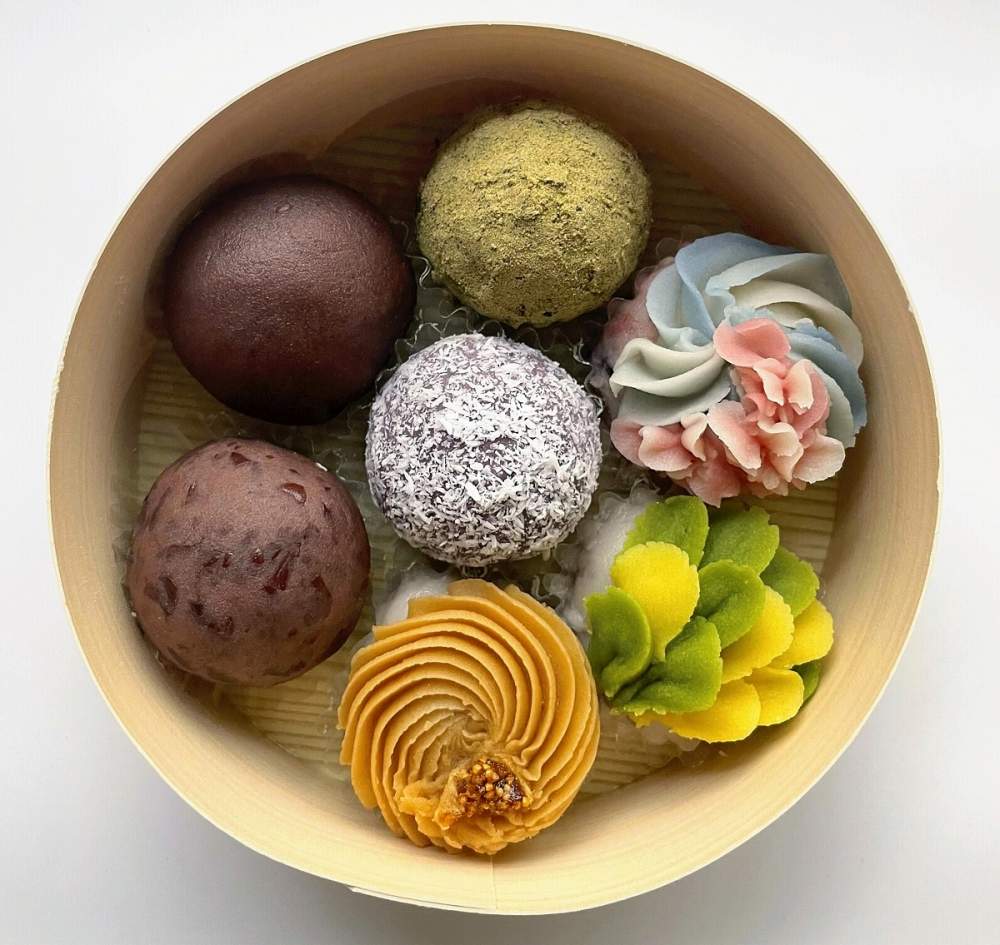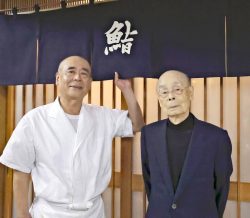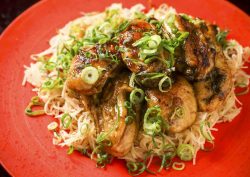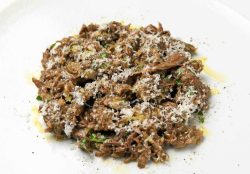
Ohagi rice balls produced by Takeno To Ohagi in Setagaya Ward, Tokyo
16:00 JST, May 16, 2023
Anko sweet bean paste, an indispensable ingredient in Japan’s traditional wagashi sweets, has been in the spotlight lately for its use in new types of wagashi. Dubbed shinkakei (modern) anko sweets and neo-wagashi, these beautiful new creations feature innovative tastes and textures.
There was a long line at Takeno to Ohagi, a store specializing in ohagi rice balls coated with anko in Setagaya Ward, Tokyo, before it opened one day in early April. The store is known for its distinctive ohagi featuring unusual ingredients such as dried fruits, herbs and spices.
The beautiful appearance of the sweets is also attracting attention on social media.
One of the ohagi offerings, Nanohana to Mitsubachi (nanohana field mustard and honeybees), uses ingredients such as shiroan smooth white bean paste, yuzu peel, honey and matcha. The ohagi is colored green and yellow, evoking the feeling of spring.
The Moka to Ichijiku (mocha and figs) ohagi spreads the aroma of coffee with just one bite. A new product featuring dried passion fruit and anko containing salted cherry blossom petals offers a harmony of refreshing flavor.
Priced between ¥180 and ¥350 each, these unconventional ohagi were created by proprietor Hiroki Ogawa, who once worked at a Spanish bar and ran a Western-style deli.
“White kidney beans, an ingredient of smooth white bean paste, are often used for European side dishes, so I use them with herbs and spices” to make ohagi, Ogawa said. “Ohagi containing nuts go well with wine.”
Ebisu Seikado, a Japanese confectionary store in Shibuya Ward, Tokyo, that features domestic fruits is known for its signature dorayaki pancakes with fruit fillings made from Japanese fruit.
In April, the store offered dorayaki filled with Yayoihime strawberries from Ibaraki Prefecture and tsubuan coarse red bean paste, as well as dorayaki with mangoes produced in Miyazaki Prefecture and white bean paste, among other items. Prices started at about ¥630 each.

Fruit dorayaki pancakes sold at Ebisu Seikado in Shibuya Ward, Tokyo
Department stores and commercial facilities across the nation are also getting in on the anko boom, holding events featuring the sweet bean paste. According to wagashi critic Naruhiro Nishii, colorful, photo-worthy sweets completely different from anko’s conventional humble image have hit shelves one after another over the past several years.
A major reason for their ongoing popularity is that these sweets have succeeded in attracting young people who were previously unfamiliar with wagashi.
Long-established wagashi stores are also producing sweets using anko with new twists and ingenuity. Ryoguchiya Korekiyo, an Aichi Prefecture wagashi store established in 1634, sells limited offerings of beautifully colored yokan jellied sweet bean paste bars featuring carnation motifs or depictions of various countries around the world.
Another example is Ginza Fugetsudo in Tokyo, which sells a yokan terrine dessert containing nuts and fruits for ¥650 per slice. It pairs well with coffee or wine.
Anko is likewise gaining popularity at cake shops and cafes. Starbucks Coffee Japan launched An Butter Sando, a bun filled with anko and a slice of butter, for ¥315 in May 2021. Cake shop operator Ginza Cozy Corner also released a cream puff stuffed with anko and strawberries in March for a limited time.
“Anko has been familiar to Japanese people for a long time. The nostalgia that the ingredient has is also appealing to many people. I hope a lot of people enjoy the unconventional appearance [of modern anko sweets] and the deep flavor [of the bean paste],” Nishii said.
Nutritional source for athletes
Anko is also gaining attention as a nutritional source suitable for athletes.
An increasing number of people are eating sweet bean paste before or after exercising as it supplements the carbohydrates depleted during physical activity.
The Tokyo-based food sales company Underwater released a drinkable sweet bean paste named theANko in 2020. Bean paste is cooked in a large copper pot and packaged in a convenient pouch with a drinking spout for athletes.
The 100-gram package comes in three varieties of bean paste — tsubuan coarse, koshian smooth, and shiroan white kidney bean paste — priced at ¥380 each.
Fukujyudo Hidenobu, an Osaka-based wagashi store, sells a gel-type anko product called ANDO_ for ¥1,044 for five sticks and shipping costs. The company developed this product in response to requests from runners who wanted wagashi they could eat while running or when they were tired from working out.
These single-serving yokan bars are also popular among hikers as a snack or emergency food.
"Features" POPULAR ARTICLE
-

Sanrio to Open Museum in Yamanashi Pref. Dedicated to Founder, Exhibits Include Hello Kitty, Other Characters
-

Legendary Sushi Chef Jiro Ono Turns 100: ‘I Have No Regrets’
-

Autumn Foliage Surrounds Visitors to Tokyo’s Showa Kinen Park
-

My Daughter No Longer Speaks to Me, But I Want to See Her and My Grandchild
-

Kumamoto: Public Bath Refurbished as Library Where You Can Chat, Take Photos
JN ACCESS RANKING
-

Keidanren Chairman Yoshinobu Tsutsui Visits Kashiwazaki-Kariwa Nuclear Power Plant; Inspects New Emergency Safety System
-

Imports of Rare Earths from China Facing Delays, May Be Caused by Deterioration of Japan-China Relations
-

University of Tokyo Professor Discusses Japanese Economic Security in Interview Ahead of Forum
-

Japan Pulls out of Vietnam Nuclear Project, Complicating Hanoi’s Power Plans
-

Govt Aims to Expand NISA Program Lineup, Abolish Age Restriction


























